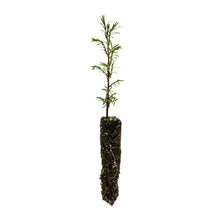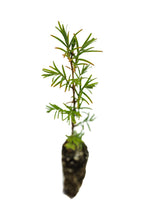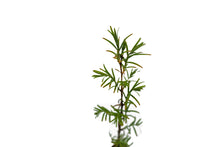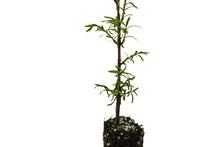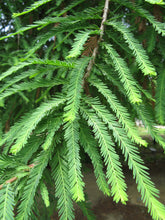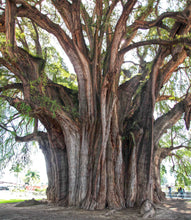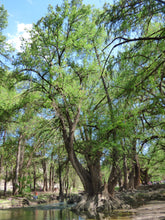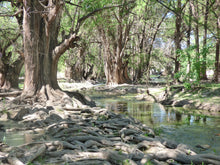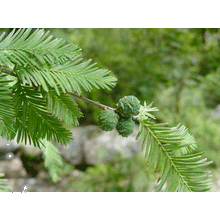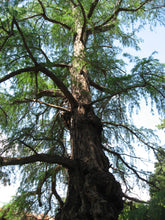
Taxodium mucronatum
-
Grow your own Montezuma Cypress, Mexico's National Tree!
- 100% guaranteed
- Seed-grown on California's Redwood Coast
- Transplanting and care instructions included
 |
Moisture Medium |
 |
Cold Hardiness 0°F |
 |
Light Full Sun / Partial Shade |
 |
Size 60 – 150' tall / 30 – 80' spread |
 |
Lifespan 1500 yrs |
 |
Growth Rate Fast Growing |
 |
Drought Tolerance High |
 |
Wind Resistance High |
About Montezuma Cypress
Montezuma Cypress — also known as Montezuma Baldcypress, Sabino, or Ahuehuete — is the national tree of Mexico and has been widely cultivated and revered there since pre-Columbian times. Montezuma Cypresses are among the oldest cultivated trees in the New World, with some planted specimens estimated at more than 1,600 years old. True old growth examples of this tree are considered sacred in parts of Mexico, and are celebrated in religious ceremonies and festivals. The common name, Ahuehuete, which comes from the the Aztec language Nahuatl (āhuēhuētl), means "old man of the water" — no doubt a reference to Montezuma Cypress's penchant for growing near waterways and in flood zones.
Native throughout Mexico, Guatemala, and up into Southern Texas's Rio Grande Valley, Montezuma Cypress is a close relative of Baldcypress (Taxodium distichum), and features a similar appearance, but without the "knees" that often form at the bases of Baldcypresses. Montezuma Cypress has a broad, spreading crown with strong, horizontal branches and delicate, weeping branchlets. Its soft needles are bright green and feather-like. In the southern part of its range, Montezuma Cypress is an evergreen with persistent needles; in the northern part of its range in Texas (and often when cultivated elsewhere), the tree can be deciduous, losing its needles in fall/winter or when new growth emerges.
A fast-growing, long-lived tree, Montezuma Cypress is most often found in marsh or spring areas, along waterways, or in canyons where surface water may not flow throughout the year, but where the tree's root system can secure perennial water below ground. It is often found growing alongside Cottonwoods, Willows, and Mesquite Trees, or in pure stands. Though commonly found in moist soils, established trees are surprisingly drought tolerant.
Montezuma Cypresses become very large, with heavily buttressed trunks, often of remarkable circumference. In fact, the tree is known as a giant more for its massive, convoluted trunk than for its height, which typically ranges from 60 to 150 feet. The record height reported for this species is around 175 feet tall, far shorter than the record-holding Redwood behemoths of Northern California (which can reach nearly 400 feet tall). Trunk diameters in old growth Montezuma Cypresses, however, are the very largest in the tree world, at up to more than 50 feet across! The biggest Montezuma Cypress in the United States is located in San Benito, Texas. It is much smaller than its Mexican counterparts, at just 100 feet tall with a trunk diameter of around 7 feet across.
Perhaps the most famous Montezuma Cypress in the world is a specimen planted by an Aztec priest on what are now the grounds of the Catholic church in the town center of Santa Maria del Tule in the Mexican state of Oaxaca (around six miles east of the city of Oaxaca). This tree is known as "El Arbor del Tule," or sometimes "The Tree of Life," and has been called "the stoutest tree in the world" for its amazing trunk size, which, including the promontories and bays of its deep buttresses, exceeds 150 feet around. In 2001, "El Arbor" was placed on a UNESCO tentative list of World Heritage Sites.
The wood of Taxodium mucronatum is not as incredibly durable as that of Baldcypress, but it is still a favored material for fine furniture-building in Mexico, and it was heavily utilized for timber during the construction of Mexico City and many other Mexican cities. Montezuma Cypresses were also used by the Aztec peoples to create arable land out of shallow lakes by strategically planting trees and filling the spaces in between with earth. Indigenous peoples relied on Montezuma Cypress for many medicines as well.
In all, Montezuma Cypress is one of the tree world's most venerable citizens with an incredible history, particularly in Mexico. It makes a fantastic planting in lawns, yards, and gardens, and can be cultivated under a great variety of growing situations, including wet soils, dry soils, and temperatures that range from triple-digit heat all way down to 0-degrees Fahrenheit.
Plant your own Tree of Life and experience this wonder of the plant kingdom for yourself!
About Jonsteen's Seedlings
All of our trees are seed-grown at our nursery on California's Redwood Coast, which is inspected monthly and licensed by the California Department of Agriculture. Trees can provide a natural barrier against high winds, temperatures, noise pollution and soil erosion, all while benefiting local air quality, wildlife and property values — a Jonsteen seedling will only grow in value and beauty!
About Jonsteen's 100% Guarantee
All of our trees are guaranteed to arrive healthy and in good condition. If your tree perishes despite your honest efforts, we will be happy to replace it with a small-sized seedling for just the cost of shipping/handling. You can learn more about our guarantee and tree replacement policy here.
Seedling Size Chart: Small
Due to the dynamic nature of actively growing trees, as well as the tremendous variation between species’ growth rates, we rely on the cubic volume of a seedling’s root mass to determine its “size” (Small / Medium / Large / XL). Within each size there is minor variance — the dimensions provided here represent the category minimum. If exact measurements are essential, please contact us about current stock.











